The “chair” exhibition juried by S Gayle Stevens, was in the Main gallery from February 16 to March 25, 2018. Gayle selected fifty four images from forty three artist. Patricia Leeds’ “Chairs Deconstructed” received the Juror’s Award. Elizabeth Sanjuan’s “La Sala” received the Director’s Award. Juror’s Honorable Mentions were given to Joel Butler’s “Café Noir”, Carol Isaak’s “The Clean-Up Crew” and David Glen Larson’s “Man’s Best Friends”. Director’s Honorable Mentions were given to Pete Holland’s “Seat at the Mausoleum”, Deborah Sfez’s “Wedding on a Bench Dresden 1947” and Thomas Zamolo’s “This Is”.
“response” juried by Amanda Smith and Kevin Tully
The “response” exhibition juried by gallery directors, Amanda Smith and Kevin Tully, was in the Main gallery from December 22, 2017 to February 11, 2018. Amanda and Kevin selected fifty seven images from forty five artist. Charlotte Watts’ “Road Kill #12 – Fawn, La Pieta” received the Juror’s Award. Carlos Detres’ “The Anxiety of Love” received the Director’s Award. Juror’s Honorable Mentions were given to Dave Hanson’s “The Valley”, Keith Kesler’s “Beware of Falling Coconuts” and Sara Silks’ “Sliding”. Director’s Honorable Mentions were given to Gary Beeber’s “Double Portrait, Providence, RI”, Charlene Hardy’s “Giggles” and Jaime Siragusa’s “The Future is Nasty”. Kathy McCall’s “Worship” received the Visitors’ Award.
—oOOOo—
“How do we respond? Many of us respond with anger. Many of us respond with disbelief. Many of us respond with indifference. Many of us respond with our cameras.
We photographers can catch devolution or evolution or revolution. We can comment without uttering a word. Beautiful metaphor and devastating irony can flutter or shout from the image. The passionate confusion of lovers can exist in time with the startling rage of provocateurs.
Response can be in the form of a psalm or an answer — an answer to life’s moments that break our hearts or set them on fire.”
Franklin Cincinnatus
“unique: alternative processes” juried by Christina Z Anderson
The “unique: alternative processes” exhibition juried by Christina Z Anderson was in the Salon gallery from November 24, 2017 to January 14, 2018. Christina selected thirty nine images from thirty two artist. Merte Lien’s “The CooCoo Tree” received the Juror’s Selection award. Ralph Wilson’s “Blues in a Bottle” received the Director’s Selection award. Donna Moore’s “Momento Mori: Aves” received the Visitors’ Award.
—oOOOo—
“It was an honor to be selected as the juror for Unique: Alternative Processes. I have practiced, taught, and written about handmade processes for almost 20 years, during which time “alt” has increased dramatically. Galleries are representing artists working in a variety of handmade processes. Museums are collecting the work. Art critics are taking notice and writing about “alt” as if it has just recently been discovered.
I judged close to 300 works by 56 artists, and to narrow my choices down to 10% of that was daunting; I could easily have chosen twice that number. Artists’ works were presented anonymously so my selections could be made without prejudice. Sometimes it is a hair’s breadth between one work and another.
32 artists were chosen for the show. Processes were widely varied: cyanotype, gum, photogravure, wet plate collodion, carbon, platinum, Van Dyke brown, intaglio, bromoil, image transfer, chemigram, mordançage, collage, lith printing, salted paper, lumenprint, and perhaps others I don’t recognize. Abstraction was well-represented, and some of my favorites were minimalist. Organics, birds, and women all figured prominently, but one of my favorite images is of leaves fallen in a hirsute man’s lap. Landscape had its prominent place: a tree’s shadow sprawling across leaf-covered pavement, a verdant forest untouched by human hand, turbulent Caspar Friedrich-like seas. The 175-year old cyanotype process is more popular now than when it was first discovered, printed on glass, paper, and fabric, one particular piece an artful combination of a photograph within a photogram accented by gold stitching. I could speak about each one of my choices and why it spoke to me, and also about those that are not in the final 33, and how that hair’s breadth factored in. Ultimately it comes down to this against that, and a juror’s (my) particular frame of reference.
For the juror’s award I kept coming back to one image that upon first glance was not necessarily in the running. Through each succeeding pass through all 300 images (a process that happens multiple times over multiple days), I kept coming back to it, a primitive image of blues and browns that references folk art, outsider art, Audubon, holiday trees. The image is both abstracted and decorative, not a perfect image but one full of beauty and depth in the way the birds are articulated, the pile of feathers below referencing the shedding of life and the passing of all things. And that’s why I chose it: it is full of subtle paradoxes, beautiful yet imperfect, happy yet sad, primitive yet sophisticated, light yet deep. It grew on me with repeated viewing.
I thank all artists for taking the time to submit work and Amanda Smith for allowing me to collaborate with her on this show. I am truly thrilled to see contemporary alt work of this caliber.”
Christina Z Anderson
The Photographic Performance 2017/Catherine Panebianco
“Benny Was A Good Boy” by Catherine Panebianco was selected during our call for exhibitions “The Photographic Performance 2017”. It was exhibited in the Salon gallery from January 19 to February 18, 2018.
—oOOOo—
“Benny Was a Good Boy began as a chronicle of my old dog’s final year but ended up being a way for me to deal with death. By photographing his slow decline, I dealt with the feelings that accompany the breaking of a connection that was so important in my life. Moving a lot as a child led me to crave connections with people or places but I was also afraid to be hurt when the connection was ultimately broken. Dogs have always been that one unquestionable connection in my life – they never failed me.
Benny Was A Good Boy series includes a hazy, grainy, closed-in mood that embodied what I was feeling at the time. Presenting the images as diptychs intensified the close relationship that existed between the two of us.”
Catherine Panebianco
The Photographic Performance 2017/Anton Gautama
This is the fourth in a series of blog posts, conversations, focusing on the many entries we received for our call “The Photographic Performance 2017” that were not chosen for exhibition in the gallery, yet we feel demand an audience.
Anton had an image in a past exhibition in the gallery, Light, titled, “Larung Gar.” It is a beautiful photograph taken in the evening of row upon row of stacked and sandwiched little crimson and vermillion and magenta houses shot through on one edge by an electric golden ochre roadway with unbroken threads of headlights and taillights. Larung Gar is the world’s largest Tibetan Buddhist Institute. It was in Seda, a county in Sichuan China. The photo depicts the homes of over 40,000 monks and nuns just prior to demolition by the Chinese Government. The image is compelling both for its wonderful display of shape and color and for its content. If Anton were to be described in the vocabulary of painters he could be called a colorist. His images grab the viewer with their strong colors and then tug harder with their poignant narratives.
How did you come to photography?
I began taking pictures with a mobile phone before 2015. Since Mar 2015 I have been working professionally as photographer with a passionate focus on documentary photography. I believe that the essence of the medium is the ability to help us understand life.
I seek unique moments that generate powerful emotional responses. With patience and determination, I often immerse myself for months at a single location pursuing my photographic observations.
My photographs have been featured in several on-line and printed magazine platforms since 2016, such as “LensCulture” and “National Geographic Travel.” My works have been exhibited at the Goethe Institute, Jakarta and Institut Seni Indonesia in Jogjakarta.
Could you please give us a little background and some insight into your process?
I first became fascinated by the complexity of the home as I observed rows and rows of old Dutch colonial structures, while working on my first book, Pabean Passage. These old colonial structures showed a distinct East-Indies architecture, an adaptation of European architecture to the tropical climate of Indonesia, which gained its popularity in the mid 18th century.
Growing up in two major cities contributed a lot to this project. Born in Makassar, I also live in Surabaya for the most part of my life. What makes this project special is that I tried to capture those places from my experiences of growing up in the two cities.
Built in the early 1900s by Chinese immigrants and based on a European design, these buildings show distinct East-Indies characteristics on the outside, while being infused with an assimilation of Chinese and Indonesian culture.
As I entered those houses, I felt the air of familiarity, a connection with the harmonious combination of two distinctive cultures that I was brought up under. Born as a third-generation Chinese-Indonesian, I was raised under the influence of the Chinese culture that my grandparents brought from the old world, while at the same time being schooled in a mainly Indonesian setting by my Indonesian-born parents.
Walking into those historic houses sparked my interest to discover more about the roots of my own cultural heritage. I felt my amazement turned into an aspiration to comprehend the lives of these Chinese- Indonesians, along with the challenges they faced to preserve their own culture while living in a whole new world.
In Indonesia, there is this notion of family home, a place where history, culture, and tradition still live for generations. Just as the proverb says, “A house is built with boards and beams, a home is built with love and dreams,” these family homes have become a testimony of the evolution of Chinese-Indonesian cultures and traditions.
For many Chinese-Indonesians, their family home was (or still is) a place for business. Packed with merchandise, and various items collected over the years by the owners, these family homes silently tell their stories. They tell the stories about love and dreams, opportunities and challenges, laughter and tears of those who have called them home.
Home Sweet Home is a one-year journey into the evolution of the Chinese-Indonesian culture. It is the story of a harmonious marriage of two beautiful cultures, three centuries in-the-making. It was not a journey without obstacles, but it certainly was one with countless rewards. What began as a challenge to obtain the owners’ consent to photograph their homes has later proved to be a beginning of new friendships. The challenge to find the appropriate houses to shoot had presented me with the privilege of listening to countless stories that offer valuable lessons in life.
What did you discover when you were making your project, “Home Sweet Home”?
As I embarked on this journey, I have discovered that there is more to a home than what meets the eyes. Beyond the evidence of economical, functional, or sentimental hoarding. Beyond the cluttered halls or the neatly-organized storage rooms. Beyond the simplicity of aging and the glitters of luxury.
There is a story in each frame, hope and dreams embedded and encrypted beneath the layers of objects that fill the space. Walls displaying pictures of joyous achievements and traumatic miseries, the good-old days and the modern reality that stole their thunder.
A home is more than merely a dwelling place, it is a monument where stories are carved and histories are made. Whether it is an aging third-generation family home or a modern private home, there is this air of familiarity, a connection, a deep sense of longing.
A pride in calling it a Home Sweet Home.
www.antongautama.com
“vistas” juried by Dan Burkholder
The “vistas” exhibition juried by Dan Burkholder was in the gallery from November 3 to December 17, 2017. Dan selected fifty four images from fifty two artist.
—ooOoo—
“Right after jurying this show I was off for two weeks of teaching and shooting in Wisconsin, Minnesota, and both Dakotas. The entire time, I was haunted by memories of the fine photography submitted for this “Vistas” show. I believe one test of good photography is an image’s visual stickiness — its capacity to burrow into your brain cells where it pops to consciousness over and over. Such was the work in this exhibition.
We are nestled in an era of treatment, not just in post-processing terms with our iPhone apps or Photoshop Plug-ins, but in the way we use exposure for motion and evidence of time. This can be a good thing or it can be as cheesy as a photographic equivalent of painting on black velvet. Fortunately, the artists represented in this exhibition know the difference. After living with these images for several weeks now, I can proclaim with total confidence that our medium is in good hands, no matter how straight, stylized or manipulated.
Congratulations on your talent, your craft and your vision. Now keep shooting.”
Dan Burkholder
Being Set Free
The unique project Being Set Free is one in which artists evolve their photographic artworks to achieve self-healing and personal discovery.
Using intuitive or conceptual processes of creation, artists evolve their respective images around each of their own physical/emotional healing goals or subjects – setting oneself free from limitations, grief, disease, loneliness, encumbrances, disappointment, all common experiences of the human condition. The images may also inspire growth, liberation and a sense of unboundedness. Being Set Free images can also come out of love, adventure or many other positive events in one’s life.
The exhibition along with the stories will be exhibited at A Smith Gallery from February 23 to April 15, 2018. Jurors were Karen Divine, Melanie Walker, Amanda Smith, Diana Perkins and Kevin Tully.
Pat Brown / So Proud She Was to Die

Hey, Baby, you don’t need a reason – it’s art. It’s creating something out of nothing, like the universe coming into existence from a singularity. You can make your own big bang, and it keeps expanding, going, going, lighting up a spark here and there. Hey, Baby, it’s metaphysics! Paper, paint, film, ferricyanide, pixels, ink, baling wire, wax, collodion, fixer. Oh and don’t forget light. Light, Baby, that’s what it’s all about. You don’t need a reason! Except to create a universe.
Cecily Caceu / Moon Drop Tales and Tea Bag Wisdom

The feeling of ancestors brewing beneath your skin, itching, itching, itching, to tell their story. Wanting to warn you about their past sadness. A sadness that permeates into your organs. Something they passed on to you without your consent. You are stronger for this inheritance. You did not ask for it, but you know, deep down inside, that this wisdom is what gives you your perseverance. There is much to learn from their moon drop tales and tea bag wisdom.
Monika Colichio / Agony

Those memories of you are crawling under my skin, pulling them out one by one with each question mark. In my head thousand thoughts, waking up before the sun. To feel less is my dream. Body is drying out, hydrated only by tears. Thinner than ever fingers, don’t want to feel anything else, no more. Close eyes. Open my eyes. Still the same. I will not! I will never again!! Get out! Get out!
Jana Curcio / Summer
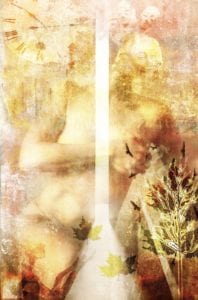
Sing to me a new song Of love that is in the stars Sing to me of hope Poured from heaven above Sing to me a new song Of passion in my heart Sing to me of joy Wrapped in my lovers arms Sing to me a new song A place where I belong Sing to me, My Love All that was me is gone.
Eduardo Fujii / Rise of the Machines
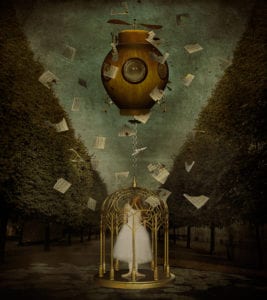
The image represents my fear of a future where AI machines rebel against and enslave the human race. For those of us, sci-fi aficionados, mixing robots and artificial intelligence is a scary combination. We watched Battlestar Galactica. We know what happens when machines evolve. In Battlestar Galactica intelligent robots called Cylons almost destroyed mankind in a 1,000-year war. Raymond Kurzweil, author of “The Age of Intelligent Machines”, predicts that we are just a few years away from artificial intelligence (AI) outsmarting the human brain. AI has already become a household term thanks to Google, Apple, Amazon, and other tech giants. Royal astronomer Sir Martin Rees believes machines will replace humanity within a few centuries. A recent technology conference in Hong Kong showcased two lifelike robots named Han and Sophia. Physicist Stephen Hawking issued a warning about the need to control technology to prevent it from destroying the human race. The threat is real!
Eduardo Fujii / The First Vision
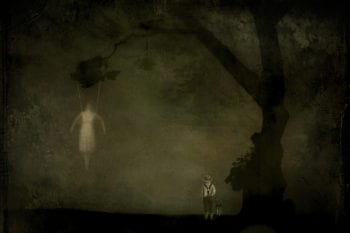
This image takes me back in time. A little boy, innocent and naive, still untouched by fear or guilt. Everything new, everything a source of wonder. I can’t remember the first time I saw my parents or was it, grandma? What a wonderful experience that might have been. My first bicycle, first dog, first rain. Who knew water could flow from the sky? The sun, the moon, the stars… I still have such a profound admiration for celestial bodies and the mysteries of the universe. The first feeling of loss came early though. It rendered me motionless, like a helpless bystander watching my most terrifying moments play out in front of me. The most inspiring first, however, was listening to my uncle play the piano. I had no idea classical music could be so touching. It touched so deep that inspired me to become a pianist, a photographer, and an artist.
Eduardo Fujii / Uncertain Destiny

Emotional healing from encrusted grief sounds like a liberating proposition. But, what if the pain has become so familiar that it makes me feel like home? I have very few memories of my mother, who I lost when I was 13. As many years have passed after that, the devastating feeling of loss has abated but I still carry it with me. The dress in the image symbolizes the dichotomy between pain and remembrance. It clings to the branch like I do to the pain in an attempt to maintain a connection to the person I loved the most and to a time in my life when I was really happy. I added an imaginary wind to provide a means to set the dress free. Do I really want to be set free?
Aubrey Guthrie / Hospice Fade Out
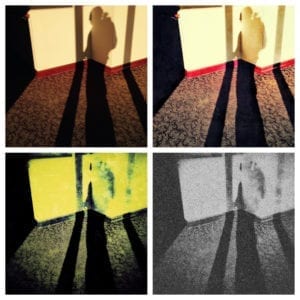
Thoughts and emotions flowed thru my body as I waited in Hospice for the freeing of her soul.
Abbey Hepner / To What You Cannot Hold

There are many things we do in an attempt to heal ourselves. We try to connect to nature and to each other. And often this connection fails to heal us… but there is beauty in the attempt. Someone who died young and healthy gave my friend lungs that both extended his life and killed him. One day in December I returned to the salt flats in Utah, where Jake and I are from, and created this photo with my husband. That day it was 11 degrees out. It was so painfully cold and we were so miserable and there was something about the way that we hid that pain… the question of helping and hurting, dependence and independence, intimacy and solitude that could exist because of our relationship to each other.
Sean MH Johnson / Mystery Landscapes 3
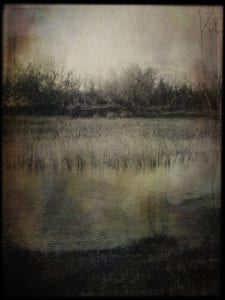
Being Set Free is Being Embraced by Beauty…
The boundless skies and seas surround us
Creating a cocoon, cradling us through life.
We imagine ourselves above and
Separate from nature.
We seem small, insignificant compared to
The majesty of a mountain or
The vastness of the oceans.
We are part of a great mystery.
Without the embrace of things bigger,
Our journey becomes meaningless.
Let go. In still moments reflecting on nature’s untamed spirit,
Allow yourself to sink into beauty’s power and comfort.
Take the wildness of sky and sea—
Let them fill your soul, lifting you to be more.
Jump into the void of these mystery landscapes.
Know that you are more than body, mind and soul.
You are part sky, part land, part sea.
Dorothy Kloss / Longing for Someone to Get It / Juror’s Selection
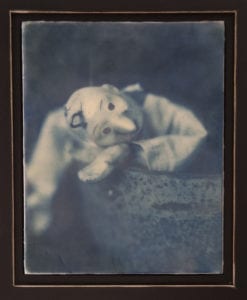
“Longing for Someone to Get It” is my struggle within raising its ugly head when my inability to communicate prevents me from leading a normal, productive life. So many times have I given up and given in that it has become the ‘norm’. This image is one I am very fond of because when people look at it they understand or have something they can relate to about it, and I don’t have to say anything. I feel as though I am free of my frustrations when I work with these puppets, even if only for a moment. I think that everyone has these moments, and everyone has that special someone or something with which they can safely silently say, ‘you get it!’ ‘Giving in’ is one approach to being set free.
Dorothy Kloss / Monsters Don’t Sleep Under Your Bed, They Scream Inside Of Your Hear / Juror’s Selection
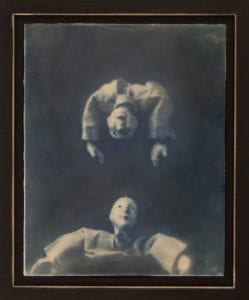
Having come from a life of almost total solitude and independence is undoubtedly a rare thing, and I can appreciate how it may not be valued. Not realizing the extent of the changes that I would face upon giving up my independence, or the changes that were expected of me, the only thing I could do is hold my emotions in. Unfortunately, it wasn’t that simple. However, when I discovered a vehicle for converting my emotions into something less destructive, it was as if a door had opened. When I finally reached my breaking point, these puppets gave me a way to express how I was feeling, even if I was unable to deal with the reality of what was causing me to feel so helpless. “Monsters Don’t Sleep Under Your Bed, They Scream Inside Of Your Head” is my way of coping with the feelings I am faced with.
Dorothy Kloss / Outside and Out of Touch / Juror’s Selection

“Outside and Out of Touch” is an expression of my inner struggle dealing with fitting in. I’ve been a loner for as long as I can remember and have never really come to terms with who I am, or better yet, who I am not. There always seem to be walls preventing me from connecting with others. Making art tears down those walls and allows me to feel free to express myself without having to defend myself. I love working with string puppets. They are a vessel for so many of my emotions and mostly, they express universal emotions.
Steve Knight / A Dream of My Grandmother
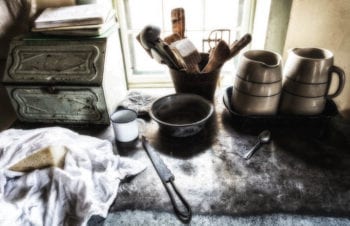
It’s 1959. My grandmother is kneading the bread dough on the metal countertop, the aroma of yeast sweet through the kitchen. A bowl of rice pudding is cooling to the side as she adds ice to the crock of fresh lemonade made just for the two of us to share. My grandfather is drinking his afternoon coffee, pouring it from the enameled cup into the saucer to cool, then tipping the saucer and sipping the still hot coffee from the edge. This morning’s milk has been separated and churned by my grandmother’s wonderful new appliance, an electric churn. I slice a thick piece of yesterday’s bread and slather it with the smooth, fresh butter using the wooden spatula still in the butter bowl. I hear a voice, my grandson saying “Pops, Pops, wake up, play with me”. Now it’s time to shape his memories.
Steve Knight / Alice and George
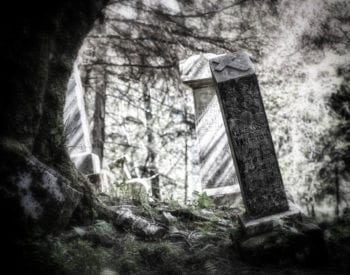
The old Sitka spruce has spent half its life encroaching on their space. But it was here a century before they arrived. Alice and George seem to resist, hopelessly pushing back with unseen force of will, of spirit, leaning into the mighty tree with all they have. But they too will topple, subsumed by its mass as all else around it has been, becoming a part of its whole. Time is irrelevant, resistance futile as the Sitka’s conquering march cannot be denied. It is patiently relentless. It is all powerful. It will win.
Art Kock / Ascension
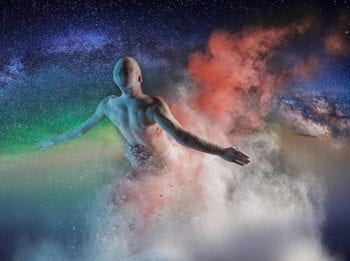
The dust symbolizes the cosmic dust that is the origin of man. Both secular science and the Scriptures state that man was formed from dust. The big bang theory, more or less, holds that planet earth and all its life forms developed from stardust, while the biblical account states that man was formed by God from the dust of the earth, which he also created (and woman from the rib of Adam). And in yet another similarity, both worldviews state that man returns to dust. “Ashes to ashes, dust to dust”. The scene communicates that leaving earth in bodily form and going to a former place of glory, having won victory over death, being set free from the physical body.
Tracy Love / Child Within
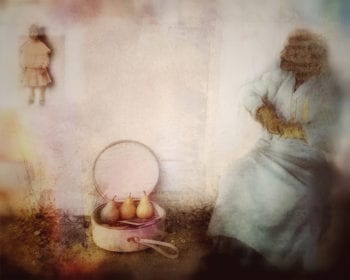
I have a childhood friend who is a constant nag. I tried to ditch her and was almost successful but just a few years ago, she found me. She reminded me of all the good times we had and the adventures we took together when we were young. I am surrounded by responsibility and commitments but her only desire is to play. So, I spend a little time with her and when we depart she always says the same thing, “When are we going to get together again?”.
Tracy Love / Out of the Shell
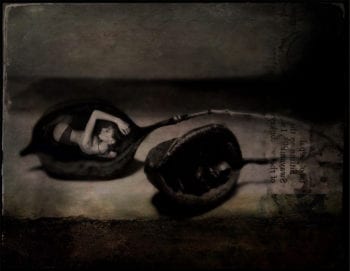
Society likes to put us into neat, little boxes. Every document we complete and sign places us into easily sortable compartments. Why do we allow this to happen? We were born wildly creative. We colored outside the lines. We danced when there was no music. We sang our own songs. The compartmentalization process is purposely slow. You awake one day to realize that you are in a shell not of your own making. Climbing out of the shell requires determination and effort. You scream out loud, “I am bigger than this” but most are not listening. So we leave bread crumbs, a beautiful picture and then another and then another. Someone looks into the shell and realizes we are gone. Our creative crumbs leave evidence of our escape and a path for others to follow.
Lynda Martin / Signals
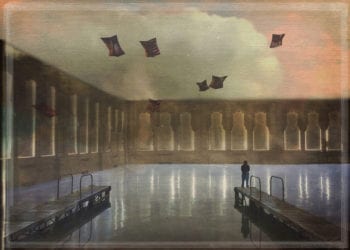
This image is about seeking guidance to move past self-limiting beliefs. Freedom is possible when intuition and nature provide inspiration. We can find our path when we remember to pay attention to the signs along the way. The signals (kites) are communications with the Divine—the prayers and often mysterious answers that guide me through life.
Bobbi McMurry/ Storm / Please Return / Nights Are Bright

An Unexpected Journey
A violent storm burst from my eyes,
my world was now in tatters.
To lose a love like yours and mine,
nothing else can matter.
I dream and bring you back to life,
wish I’d never wake.
Morning comes and I’m still here,
alone with my heartache
I strive to gain perspective,
to put things in their place.
Days are dark, and nights are bright,
within this empty space.
I feel your presence everywhere,
Yet miss you all day long.
I hear your voice inside my head,
a sweet and gentle song.
Warmth came through my window,
caressing me as you.
I’m reminded of my blessings,
to have loved someone so true.
The sun reflected off his wing,
I watched him freely soar.
Life goes on without you,
but you’re with me ever more.
Lucinda Nicholas / naked now look at my body
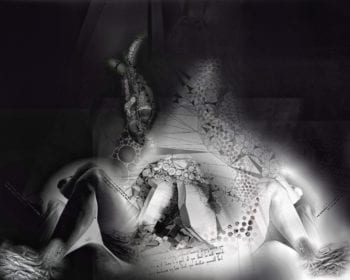
I used the words ‘hell…wanting to be somewhere different…dying before you die’ to describe how it feels to look in the mirror and be disheartened by what you see. That feeling that you are so ugly, so not how you want to be, that you cannot imagine how anyone could look at you with love. My image is exploring the freedom that comes when you accept your body and its limitations. There is the negative and the positive and they combine to form something that goes beyond the physical, something that you feel in your spirit despite your feelings about your body. I struggle with body image issues, and it’s only recently I have set myself free from that feeling of loathing when I look in the mirror and instead started cultivating a more healthy look at a person’s inner beauty.
Vicki Reed / Letting Go
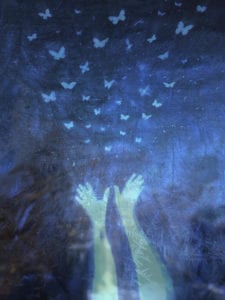
Orphaned at Sixty-five
No More
seeing her laugh at the dancing girl in the tree outside her window
pleas to take her home though she did not know where home was
late night calls to soothe her and distract her from anxiety attacks
thanking her for teaching me how to be a good mother
walking halls with her in a manic search for a lost child
hearing him whistle to his favorite songs
seeing him tuck her in to keep her warm
making the staff laugh with his teasing
feeding him his favorite chocolate pie
doing their nails, massaging their feet
singing along to music of the forties
taking them for rides for ice cream
loving embraces as they sleep
sharing memories and laughs
hearing, “JERE!” “Yes, Dear.”
wheelchairs and walkers
strokes and blank stares
gentle hospice workers
sundowners syndrome
labored breathing
falling down
morphine
suffering
oxygen
worry
them
us
Michelle Ridlehoover / Do you see me?
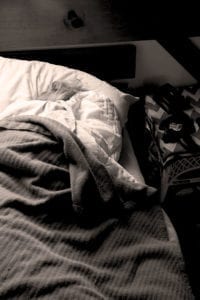
Do you see me? My life to the service of others. Many hate me. My “skin”. My uniform. Cursed at, spit on, life threatened, family threatened. I see your pain. Anger. Frustration. Spit on my face…I face your hatred. A uniform not because I am a racist pig. Not because I like watching people take their last breaths. I am not ignorant of the injustices of the past. I don’t want to cover up the injustices of the present. Do you see me? A uniform because I was brutalized. Beaten. Humiliated. Made to feel worthless. I can’t wrap a bullet proof vest around that young woman. Do you see my wounded warrior? Or a racist pig? When ignorance and hate open fire,…I will die to protect you. Everyday, I rise from my peace. Put on my badge. Show myself that I make a difference. Do you see me?
Stefynie Rosenfeld / Untitled
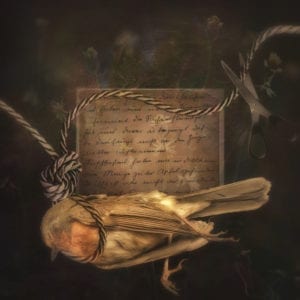
Lost in a polluted mind, her wings fell silent. When paths to kinder shores shown breadcrumbs to their doors, she found she remembered how to fly.
Beth Sanders/ Untitled
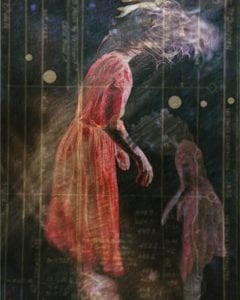
This image is about the ties I have had to the past that were crippling me. It’s me in my mothers dress that represents a need for me to see me for who I am not through the lens of my mother. Why I am looking back at myself.
Deborah Sfez / Childhood Mirage 2

HOME-LAND
Homeland
Is neither a Home nor a Land
It is the Womb
From where you are born
With it’s warm or cold nature,
The language
You first hear and use to express
Your very first desires and thoughts,
It’s the story you are told
About your parents and ancestor
And the God or Gods
You are urged to believe in
And trust,
Homeland is the Landscapes
That live in your mind and soul
With their unique weather and seasons
That influence your mentality
Shape your behavior
Your temper
Your moods
And
Your humor.
Deborah Sfez / Circus 2
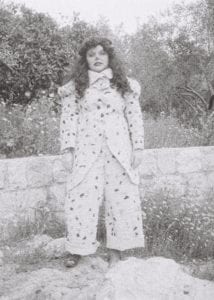
THE JESTER
He is the fool
Who tells you a legend
You want to believe in
With magic words
Carries you
To a Planet unknown
He is the great acrobat
The Dancer
Who floats in the air
In circles
And makes you understand
That the universe
Unfolds For those who realize
That roundness
Applies in two dimensions
The one you can grab
The rest unseizable.
Lynda SmithSchick / Fragility of Fog 5
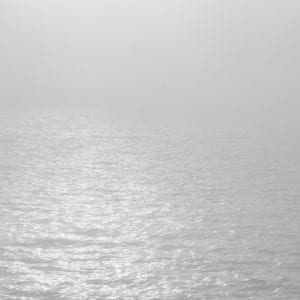
Fragility of Fog Fear took up residence like a squatter, during fragile moments of contemplating obscured emotions. This project came in hindsight as I considered the diverse emotions that had accompanied my life’s events: fear, joy, loneliness, calm, anger, hope, sadness and anxiety. From repeated traumas through the years, I needed the lens of art to chronicle the range of emotion I’d experienced and managed in a transformative, liberating way. Being set free on the other side of this this examination, I understand the fragility of fog — amorphous and transient. We peek behind fog’s seemingly substantial veil, finding nothing. The misty layers mimic our emotions, enveloping and transforming earth for a time.
Jason Tannen / The Letter
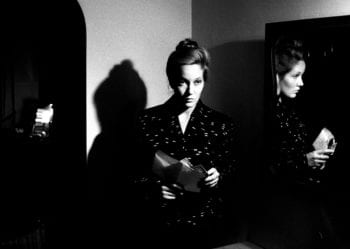
The letter came in a film noir moment, slid under the model’s door, interrupting the photography session – a friend of a friend whose headshots were making their way around the City. Her home was already dark, already required lamplight for reading. In the opening of the envelope, her shadow shifted on the wall. An empty letter and petty cash – two fives – to what purpose? The spit on the sidewalk? The last word? The composition was replete with dualities the photographer knew well. Harsh highlight; deep shadow. Foreground figure; background set-piece. Also present, under the surface: Pain; relief. Grief; hope. The shooter took his shot, and the moment perched in the air, the static suspense between two eras: the before waiting for the after, the slug of life in motion and the exhale to something new. ––Narrative written in collaboration with Jacquelyn Spangler, 2017
Benita VanWinkle / Winter Sunrise
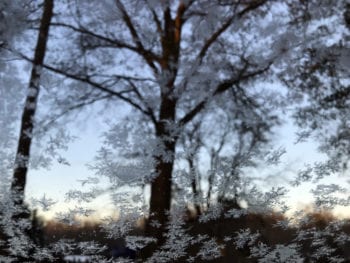
For over two years, I sent a photograph to my friend on her phone, a reminder that she was loved. She had been diagnosed with a life threatening illness, and the images became a game to find a sparkly something to make her smile. I found silly juxtapositions, achingly beautiful sunrises, frost on winter grass and windows. Sidewalk chalk messages left by unknown artists appeared in front of me, color bursting first blooms of spring danced in the wind, snails inched across my path. What a gift to have someone to share a secret little smile with every morning. Now her daughter gets the photographs.
Charlotte Watts / The Lines Of My Hand
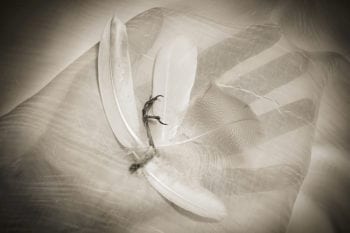
The Lines Of My Hand
On holding bird in my hand
My hand my arm my nerves my brain
can only fix the tilt of wings,
can only draw long dead remains.
But oh they give me hope, they sear my deepest being
that I will soar as weightless as a child again.
The Photographic Performance 2017/Lori Pond
This is the third in a series of blog posts, conversations, focusing on the many entries we received for our call “The Photographic Performance 2017” that were not chosen for exhibition in the gallery, yet we feel demand an audience.
We met Lori Two years ago at PhotoNOLA. She has had work in the gallery previously and we have seen and admired much of her work online. However, to walk up on her Bosch Redux series at the portfolio walk was a revelation.
My freshman year in college, before I was an art major, my best friend, who was a year older, was studying art and he brought home an art history book at semester break. Leafing through the textbook I came upon Bosch’s “Garden of Earthly Delights.” I think it might be the first time that I really “looked” at a painting. It was shocking, titillating, repelling, amusing, but most importantly it was thought provoking – what in the hell was he trying to say? Since, I have seen it described as an unapologetic celebration of voyeurism or a dire warning of the evils of partaking in the temptations of the flesh. No matter which interpretation was intended it is captivating and seductive. Lori’s photographic interpretations of elements of the grand painting are equally fascinating and compelling. Yet, because they are graphic recreations of single images or vignettes taken from the chaotic whole they become uniquely her own.
How exactly did I get started on Bosch Redux? What if anything did I have to learn in order to successfully complete it?
It was quite the undertaking, because I had never done a studio shoot before, or worked with models. I solved the model issue by cajoling my friends into modelling for me. Neither I nor they knew what we were getting into, though. My models ended up doubling as wardrobe, set, makeup, and props people in addition to posing for me. (For Bosch Redux 1.0, I recruited my model to paint his own costume.) We all learned together along the way. I am eternally grateful to them!
I work on a television talk show in the graphics department, so I’m around a bunch of very talented crew people who made costumes, props, custom lighting equipment, etc. for me that greatly helped me accomplish this work. For example, I had a life-size boat made for Bosch Redux 4.0, two otherworldly costumes made for Bosch Redux 14.0 and Bosch Redux 17.0, and prosthetics made for Bosch Redux 2.0 and Bosch Redux 12.0.
Why Bosch?
I discovered Hieronymus Bosch’s work in a high school art class, and I was hooked ever after. I had never seen anything like his work and wondered where he came up with all of his fantastical creatures and settings. A few years later I got to see his masterpiece, “The Garden of Earthly Delights,” at the Prado Museum in Madrid and was wowed. I then purchased a print of it, which hung in my living room for years. When I bought the Taschen book of Bosch’s complete works years later, my fascination then turned into a self-admitted obsession, and I decided to make work based on his paintings. I made a trip to Holland in 2016 to attend the Bosch 500 Festival, celebrating the 500th anniversary of his death. I learned a lot more about Bosch the artist and the man. I came back home with the realization that his work is all about good vs. evil, and that each of his paintings are morality plays.
Who inspires me?
I’m inspired by so many people and things. The photographer Jerry Uelsmann has always been a favorite because of his singular vision and technique; Ludwig van Beethoven’s music provides me with solace and courage; moonlight reflected in a dew drop shows me the whole world; poets Mary Oliver and Dogen (12th century Buddhist monk) ignite my curiosity; painters Wayne Thiebaud and Mark Rothko inspire through their very different uses of color.
The Photographic Performance 2017/ Bill Motley
This is the second in a series of blog posts, conversations, focusing on the many entries we received for our call “The Photographic Performance 2017” that were not chosen for exhibition in the gallery, yet we feel demand an audience.
Bill Motley is a photographer from San Antonio, Texas. We think his project is important for two reasons: Cuba is currently in the news – President Obama started to mend relations between the two countries and President Trump is falling back, taking us back to an old Cold War stance.
Bill has gone to Cuba trying to make connection. His project is about connecting.
Why is your series of photographs titled “The Unseen Cuba”?
When I travel I make a point to go where the tourists aren’t. I have a t-shirt that says “All those who wander are not lost”. This pretty much speaks to how I approach my photography. I love wandering the back streets or countryside wherever I go. Of course you can’t be in Havana without photographing on the city seawall called the Malecon but I wanted more. On both trips to Cuba our group had the good fortune to work with two Cuban professional photographers, twin brothers, who live in Havana. They were able to open doors, literally and figuratively resulting in the most incredible experience on both a personal and photographic level. While there are many iconic images of Cuba, I wanted to capture the day to day lives of the Cuban people that very few, if any, tourists will ever see and hope my photographs accomplish this.
Is your photography generally focused on “street shooting”?
No, not at all. I’m primarily am a landscape photographer but couldn’t pass up the opportunity to go to Cuba. Photographing people was a totally new experience for me. I was initially very uncomfortable approaching people to photograph. One of my mentors on the trip pushed me to get up close and be part of the experience. Fortunately my wife speaks fluent Spanish so she was also able to bond with the people. Trust me, this was much better than me pointing my camera at someone and smiling hoping they’d understood I wanted to photograph them. I also found myself drawn to the architecture and amazing colors everywhere. A majority of the buildings we saw were suffering from decades of terrible neglect however this presented me with new opportunities. The countless layers of paint on these old buildings were stunning as were the old colonial style buildings. One can only imagine what Cuba looked like in its heyday.
What did you take away from your photography experience in Cuba?
By far was learning the importance of getting outside my comfort zone as a photographer. It took a couple of days to gain the courage to approach people and ask to photograph them but over time it became fun. On our second trip my wife took a Fuji instant camera and gave small photos to everyone I photographed. I was amazed by how many Cubans had never seen a photograph of themselves. I was also struck by how innovative, hard working and incredibly friendly the Cuban people are. They almost universally love the United States and peppered us with questions when they learned we were Americans. My overall experience in Cuba went far beyond photography and touched me in a way I never expected.
The Photographic Performance 2017/ Joan Brook and Jim Houser, PhD
Walls
Introduction
By Joan Brook and Jim Houser, PhD
This is a joint technical and artistic study. Both of us approach walls differently, Jim, the technician, emphasizes function while Joan, the photographer, focuses more on artistic form. We sought out walls to provide a visual, contextual, and technical framework for the rise in separateness and division we see throughout the world. The photographs in this exhibit portray the progression of that study, beginning in Israel in 2015 with one of the oldest walls people are still fighting over, the Western or “Wailing” Wall of Jerusalem built in 19 BC. In Spring of 2017 we went to Berlin to document and study the famous wall that separated a city and symbolized the Cold War. And finally, in the stifling dusty heat of a Texas summer, we visited the Rio Grande and the border wall between Eagle Pass, USA and Piedras Negras, Mexico. In the future, our project will continue along the southern border of the US, studying existing and proposed wall sites, and we will return to Israel to study a wall that perhaps best exemplifies the intent of the US southern border wall, the West Bank Wall between the Occupied West Bank and Israel. Ultimately we will face and document the confrontational Green Line dividing East and West Jerusalem that, to us, symbolizes the rise of divisiveness in the world.
Walls
Why Walls?
Joan: Before “Build the Wall!” became the current political rallying cry, I have been photographing walls. It’s difficult to ignore them. Walls, in both function and form, provide safety from the elements, quiet, privacy and seclusion. They also act as barriers, separating us from nature, other people, relationships, and interactions. With this isolation, come certain blessings as well as liabilities. I pursue stories exploring the secrets held within walls, discovering when they were built, and with what materials, because I’m passionate about the history of places and preserving that historical perspective. I seek to explore lines in the abstract, finding intersections and angles like a tangram puzzle. I also like photographing decay, because as materials age, they change. As things break down, growth can occur, either through adaptation, or complete destruction. In today’s political climate, and for this project, we chose to focus on walls as architectural portraiture, on their construction, maintenance, and need for reconstruction, on their surfaces for artistic revolution, and over time, in their fragility.
Jim: Why walls? Because, apparently, our country has committed to the massive infrastructure project of building a wall along the entire 1,954 mile border of Mexico. Our intentions were made clear when the presidential candidate who promoted this wall, and made its construction a central promise of his campaign, won the election. As a technologist, I am interested in the nature of that commitment. What will it take, technologically, to build such a wall, and what are the impacts and costs? These are essential questions to ask if someone wants to actually build an effective border security wall and not just an expensive symbol. In order to answer those questions, Joan and I have taken to studying and visiting contemporary border walls to better understand what it takes to make such a wall effective, and the effects those walls have. We have visited the Israeli West bank Wall, an existing border wall in Eagle Pass, Texas, and remnants of the old Berlin Wall. The pictures in this exhibit represent that journey, which has only just begun. There is so much to learn about walls.
Walls
What side are you on?
Joan: Borders don’t occur naturally in nature, unless they’re a coastline or shore. Animals don’t heed borders or understand the distinction. Only humans create borders, and thereby create sides. By addressing “which side are you on” we examined these borders, these skewed perspectives and obtuse indiscriminate slices in the landscape. Unfortunately, everywhere we visited, the function of these jarring cuts in the land was to sever one group from another, usually families. On the Mexican/U.S. border, it was often difficult to tell which country we were standing in. Only the flag gave it away.
Jim: If one is to build a wall, it is important to know which side you are on, since one side may have a different function than the other. Contemporary border walls, like the Berlin Wall and the DMZ in Korea, include a patrolled buffer zone between two walls (the wall on the actual border and the wall that is the edge of the patrolled buffer zone), making orientation a particularly important design consideration in proper wall construction. For instance, along the U.S. border with Mexico, the wall on the actual border will be opaque so that people approaching from the Mexican side will not be able to see in, and the wall on the edge of the buffer zone will be transparent, so that U.S. border agents can easily see into the buffer zone. However, we found, in our attempt to document and study these walls, that photographs by their very nature create a framed perspective that often makes proper orientation difficult. For instance, in the specific case of the U.S. border wall, it is sometimes difficult to know, just from the visual cues of a photograph, which side of the wall you are on. Looking through a wall from the U.S. side you might assume you are seeing across into Mexico, when actually you are looking into the U.S. buffer zone. In Eagle Pass, Texas, you could be looking through the border wall and see a Latino family playing putt-putt, and assume you are looking at Mexicans enjoying a nice evening, but you would be wrong! A strange anomaly created by the border wall in Eagle Pass, is a nine-hole golf course completely fenced in by the buffer zone. If you want to play golf you have to go through one of the border wall gates (and hope they don’t close behind you). Nevertheless, among all this confusion, there is a defining point of orientation in Eagle Pass, the Rio Grande. If you are looking through a wall to the Rio Grande, it is probably safe to assume you are looking from the U.S. side, since the U.S. can only build the wall on its own territory. Without the river, however, the landscape and housing is essentially indistinguishable from one side of the border to the other. If the photograph is just the wall in a landscape, it is almost impossible to know where you stand.
Walls
What is the Promised Land?
Joan: History, literature and theater engulf us with stories about claims to land, land wars and staked property. What is it about one’s homeland that tugs at us and draws us to return, to protect, to die for? “Where are you from?” is the most standard greeting among us. This land then gives us our identity, ancient and modern culture, heritage, and traditions. Most of us don’t leave our home country without a good reason, and yet, thousands of people cross borders every day, willing to sacrifice everything to call a new country home. We limit their numbers with quotas, detain them, criminalize them, imprison them, separate children from their parents and women from the men, threaten them with deportation and discriminate against them.
And still they come. Evidently, the US represents freedom, equality, and opportunity to the rest of the world. What more can we do to convince them they’re wrong?
Jim: It is assumed that Mexican’s see the U.S. as the Promised Land which they hope to enter. A land of milk and money. Or certainly that is how those in the U.S. perceive it, hence the need for a wall to prevent “others” from entering the land that is promised to them alone. A nation does not fulfill its promise to its own citizens if non-citizens are allowed to enter and reap the benefits of the Promised Land. In this way the wall we are contemplating is fundamentally different from the walls built in Berlin and along the DMZ. Both those walls were ostensibly built to keep their own people from reaching the Promised Land, but, at the same time, designed to protect the isolated utopia of the Promised Land they hoped to create. The U.S., conversely, is trying to keep people out. How does that different purpose effect the promise of a wall? Does it ensure the protection of the Promised Land, or alter it in some way we might not even understand? As we contemplate this massive infrastructure project, what is its promise for our future?
